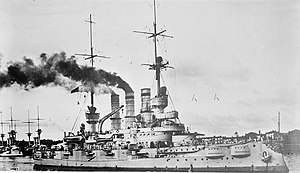SMS Schlesien

Schlesien before World War I
|
|
| History | |
|---|---|
|
|
|
| Name: | Schlesien |
| Namesake: | Schlesien |
| Builder: | Schichau, Danzig |
| Laid down: | 19 November 1904 |
| Launched: | 28 May 1906 |
| Commissioned: | 5 May 1908 |
| Fate: | Mined off Swinemünde in 1945, scrapped 1949–1956 |
| General characteristics | |
| Class and type: | Deutschland-class battleship |
| Displacement: |
|
| Length: | 127.60 m (418 ft 8 in) |
| Beam: | 22.20 m (72 ft 10 in) |
| Draft: | 7.70 m (25 ft 3 in) |
| Propulsion: | 18,664 ihp (13,918 kW), three shafts |
| Speed: | 18.5 knots (34.3 km/h; 21.3 mph) |
| Range: | 4,770 nmi (8,830 km; 5,490 mi) at 10 knots (19 km/h; 12 mph) |
| Complement: | 743 |
| Armament: |
|
| Armor: |
|
SMS Schlesien was one of the five Deutschland-class pre-dreadnought battleships built for the Kaiserliche Marine between 1904 and 1906. Named after the German province of Schlesien, she was built at the Schichau-Werke shipyard in Danzig, where she was launched on 28 May 1906. She was commissioned into the navy on 5 May 1908. The ships of her class were already outdated by the time they entered service, being inferior in size, armor, firepower and speed to the revolutionary new battleship HMS Dreadnought.
After commissioning, Schlesien was assigned to the I Battle Squadron of the High Seas Fleet. She served with the fleet throughout the first two years of World War I; by this time she had been transferred to the II Battle Squadron alongside her four sister ships. Schlesien was present at the Battle of Jutland on 31 May – 1 June 1916, where she was actively engaged only briefly. After Jutland, she was relegated to guard duties before being withdrawn altogether in 1917, when she became a training ship. The Treaty of Versailles permitted the German navy to retain eight obsolete battleships, which included Schlesien, to defend the German coast. She saw extensive service with the reorganized Reichsmarine; in the 1920s and 1930s the ship was rebuilt and eventually converted back into a training ship.
Schlesien saw limited combat during World War II, including the invasion of Norway in 1940. After the conclusion of the operation, the ship was again given secondary duties. She ended her career as an anti-aircraft ship in the Baltic; in April 1945 Schlesien steamed to Swinemünde to restock her ammunition and evacuate wounded soldiers when she struck a mine on 3 May. She sank in shallow water, though much of her superstructure, including her main battery, remained above water. In the remaining days of the war, Schlesien used her heavy artillery to provide support for retreating German ground troops. After the end of the war, she was broken up, though some parts of the ship remained until the 1970s.
...
Wikipedia
